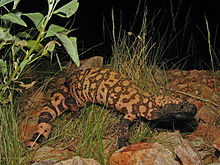Neoanguimorpha
| Neoanguimorpha | |
|---|---|

| |
| Slowworm (Anguis fragilis) | |

| |
| Gila Monster (Heloderma suspectum) | |
| Scientific classification | |
| Domain: | Eukaryota |
| Kingdom: | Animalia |
| Phylum: | Chordata |
| Class: | Reptilia |
| Order: | Squamata |
| Suborder: | Anguimorpha |
| Infraorder: | Neoanguimorpha Vidal & Hedges, 2009 |
| Subclades | |
Neoanguimorpha is a clade of anguimorphs comprising Monstersauria (represented today by helodermatids) and Diploglossa (Xenosauridae and Anguioidea).[1][2][3][4][5] Morphological studies in the past had classified helodermatids with the varanoids in the clade Platynota,[6][7] while the Chinese crocodile lizard was classified as a xenosaurid.[8] However molecular work found no support in these groupings and instead has found the helodermatids more related to Diploglossa, while the Chinese crocodile lizard and varanoids to form the clade Paleoanguimorpha.[2][3]
Below is the phylogeny of the neoanguimorph lineages after Pyron et al. (2013):[3]
| Neoanguimorpha |
| ||||||||||||||||||||||||
See also
[edit]References
[edit]- ^ Fry, Bryan G.; Vidal, Nicolas; Norman, Janette A.; Vonk, Freek J.; Scheib, Holger; Ramjan, S. F. Ryan; Kuruppu, Sanjaya; Fung, Kim; Blair Hedges, S.; Richardson, Michael K.; Hodgson, Wayne. C.; Ignjatovic, Vera; Summerhayes, Robyn; Kochva, Elazar (2005). "Early evolution of the venom system in lizards and snakes". Nature. 439 (7076): 584–8. Bibcode:2006Natur.439..584F. doi:10.1038/nature04328. PMID 16292255. S2CID 4386245.
- ^ a b Vidal, Nicolas; Hedges, S. Blair (2009). "The molecular evolutionary tree of lizards, snakes, and amphisbaenians". Comptes Rendus Biologies. 332 (2–3): 129–39. doi:10.1016/j.crvi.2008.07.010. PMID 19281946. S2CID 23137302.
- ^ a b c Pyron; Burbrink; Wiens (2013). "A phylogeny and revised classification of Squamata, including 4161 species of lizards and snakes". BMC Evolutionary Biology. 13: 93. doi:10.1186/1471-2148-13-93. PMC 3682911. PMID 23627680.
- ^ Zheng, Yuchi; Wiens, John J. (2016). "Combining phylogenomic and supermatrix approaches, and a time-calibrated phylogeny for squamate reptiles (lizards and snakes) based on 52 genes and 4162 species". Molecular Phylogenetics and Evolution. 94 (Pt B): 537–547. doi:10.1016/j.ympev.2015.10.009. PMID 26475614.
- ^ Wiens, J. J.; Hutter, C. R.; Mulcahy, D. G.; Noonan, B. P.; Townsend, T. M.; Sites, J. W.; Reeder, T. W. (2012). "Resolving the phylogeny of lizards and snakes (Squamata) with extensive sampling of genes and species". Biology Letters. 8 (6): 1043–6. doi:10.1098/rsbl.2012.0703. PMC 3497141. PMID 22993238.
- ^ McDowell, S.B.; Bogert, C.M. (1954). "The systematic position of Lanthanotus and the affinities of the anguinomorphan lizards". Bulletin of the American Museum of Natural History. 105: 1–141.
- ^ Lee, M.S.Y. (1997). "The phylogeny of varanoid lizards and the affinities of snakes". Philosophical Transactions: Biological Sciences. 352 (1349): 53–91. Bibcode:1997RSPTB.352...53L. doi:10.1098/rstb.1997.0005. PMC 1691912.
- ^ Bhullar, B. A. S. (2011). "The Power and Utility of Morphological Characters in Systematics: A Fully Resolved Phylogeny of Xenosaurus and Its Fossil Relatives (Squamata: Anguimorpha)". Bulletin of the Museum of Comparative Zoology. 160 (3): 65–181. doi:10.3099/0027-4100-160.3.65. S2CID 86328454.
